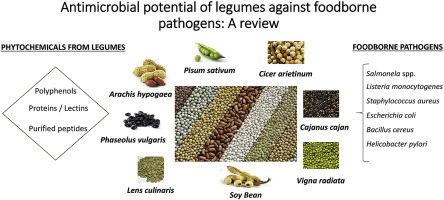Trends in Food Science & Technology ( IF 15.3 ) Pub Date : 2017-12-19 , DOI: 10.1016/j.tifs.2017.12.007 M.C. Pina-Pérez , M.A. Ferrús Pérez

|
Background
Alternative protein sources are being investigated in response to increasing consumer demand for innovative and healthy food products of vegetable origin to replace non-sustainable animal exploitation. The Leguminosae family includes a wide variety of plants and nutritious seeds, very rich in protein with a high biological value, carbohydrates, vitamins and minerals. Not only the seeds but also the aerial parts, pods, hulls and roots have proved to be natural sources of antioxidants, and anti-inflammatory and antimicrobial compounds.
Scope and approach
The present article overviews the antimicrobial potential of the most popular legumes worldwide against foodborne pathogens.
Key findings and conclusions
According to the literature reviewed, soybean and chickpea are the two consumed legumes with the highest antimicrobial activity. Long-chain soy peptides (IKAFKEATKVDKVVVLWTA) have a high antimicrobial potential against both Gram-positive and Gram-negative bacteria at a concentration level of 37.2 μM. Also, a wide spectrum of proteins and peptides in raw chickpeas and processed extracts have exerted antimicrobial activity against foodborne pathogens when applied in the range 8–64 μg/ml. These results open a new research line with good prospects regarding the development of a new generation of natural preservative ingredients and extracts to be included in novel formulated products. However, critical aspects, such as (i) the stability of antimicrobial activity during the shelf-life of newly formulated food products, and (ii) the microbial inactivation kinetics generated in novel matrices, should be covered prior to exploitation of legumes as sources of novel technological ingredients with antimicrobial potential.
中文翻译:

豆科植物提取物对食源性病原体的抗菌潜力:综述
背景
为了满足消费者对植物来源的创新和健康食品的日益增长的需求,正在研究替代性蛋白质来源,以替代不可持续的动物开采。豆科家族包括各种各样的植物和营养种子,它们富含具有高生物学价值的蛋白质,碳水化合物,维生素和矿物质。不仅种子,而且空中部分,豆荚,外壳和根部也被证明是抗氧化剂,抗炎和抗菌化合物的天然来源。
范围和方法
本文概述了世界范围内最流行的豆类对食源性病原体的抗菌潜力。
主要发现和结论
根据文献综述,大豆和鹰嘴豆是两种食用豆类,具有最高的抗菌活性。长链大豆肽(IKAFKEATKVDKVVVLWTA)在37.2μM的浓度水平下对革兰氏阳性菌和革兰氏阴性菌均具有很高的抗菌潜力。同样,当鹰嘴豆和加工后的提取物中的多种蛋白质和多肽以8–64μg/ ml的量施用时,对食源性病原体也具有抗菌活性。这些结果为新的天然防腐剂成分和提取物的开发开辟了一条具有良好前景的新研究路线,所述天然防腐剂成分和提取物将被包括在新型配方产品中。但是,一些关键方面,例如(i)在新配制食品的保质期内抗菌活性的稳定性,


























 京公网安备 11010802027423号
京公网安备 11010802027423号